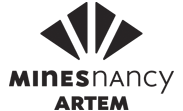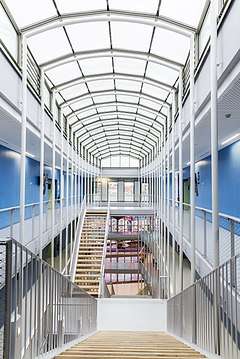École nationale supérieure des mines de Nancy
Mines Nancy (École Nationale Supérieure des Mines de Nancy in French or Nancy School of Mines in English; also referred to as ENSMN, École des Mines de Nancy or Mines Nancy) is one of the leading French engineering Grandes Écoles.
École Nationale Supérieure des Mines de Nancy | |
 | |
Former names | 1919: Institut Métallurgique et Minier 1920: École Supérieure des Mines et de la Métallurgie 1951: École Nationale Supérieure de la Métallurgie et de l’Industrie des Mines de Nancy 1985: École Nationale Supérieure des Mines de Nancy |
|---|---|
| Type | Grande école |
| Established | 1919 |
| Director | François Rousseau |
| Students | 803[1] |
| Location | , |
| Campus | Urban |
| Colors | Black and White |
| Affiliations | IMT - Institut Mines-Télécom, University of Lorraine, GEM - Groupe des Écoles des Mines, INPL - National Polytechnic Institute of Lorraine, CGE - Conférence des Grandes Écoles, ARTEM |
| Website | www |
It is located in the campus Artem, in the city of Nancy, Eastern France (only 1h30 from Paris by TGV), and is part of the University of Lorraine. Around 400 students are taught general science and management and 300 follow specialised Master programs. These students are taught by 60 permanent professors. There are also 400 researchers including a hundred PhD students. Despite its small size, it is well represented in the French industry. Most of its alumni hold executive positions in the industry and large corporations or scientific research positions in France or abroad.
It was created in 1919 on the request of the University of Nancy in order to contribute to the reconstruction of the mining and steel industry in the east of France after World War I. At the end of the 1950s, under the impulse of its then-director Bertrand Schwartz (younger brother of Laurent Schwartz), the school reorganized its curriculum to include a balanced blend of engineering, management and social sciences. At the time, it was an innovative educational model for engineers, that was later extended to other Grandes Ecoles.
The Ingénieur civil des Mines degree
Description
The school was initially aimed at training mining engineers. In 1957, its director Bertrand Schwartz began its transformation into a modern "generalist" school. The school focuses on training innovative managers for the industry and researchers, with a broad generalist and high scientific knowledge, able to communicate in different languages. The Ingénieurs civils des Mines degree (Master of Science and Executive Engineering) is ranked among the best French Grande Ecole degrees. 20% of the students are international students, mainly from Morocco, Tunisia and China. In addition to the general science (advanced mathematics and physics) and management classes, the students have to specialise (one third of their classes) from their second year to the third (and last) year:
- "Département Matériaux" (materials and mechanics)
- "Département Énergie" (energetics and environment)
- "Département Génie Industriel" (applied mathematics and industrial engineering)
- "Département Information et Systèmes" (computer science)
- "Département Géoingénierie" (geosciences and civil engineering).
The students must learn English and at least another language.
Internships
The students have to do at least three internships in order to get the degree.
- Operator internship (6 weeks), whose aim is to discover the reality of work, become aware of the repetitive nature or physical difficulties of the tasks and understand human relations within a company.
- Assistant-engineer internship (at least 10 weeks).
- Engineer internship (at least 20 weeks, usually around 6 months), the end-of-course thesis has to be research oriented.
The engineer internship is usually an opportunity for the companies to hire the students.
Admission
For students having studied in the Classe Préparatoire aux Grandes Ecoles (a two-year highly selective undergraduate program in Mathematics, Physics), admission to the Ingénieur Civil des Mines degree is decided through a nationwide competitive examination ( Concours Commun Mines-Ponts) and their origin can vary: MP, PC, PSI..., with a number of places for each which was, in 2015:
- MP: 54
- PC: 32
- PSI: 40
- PT: 4
- TSI: 3
- CCP (concours commun polytechniques): 5
- AST: 5
It is also possible for student to be accepted for specialised master's or an exchange programs, in particular through partnerships with other schools or universities around the world.
The Engineering Degree in Industrial Engineering and Materials
Description
Industrial Engineering and Materials engineering programme [Ingénieur de spécialité Génie Industriel et Matériaux] was born in 1991 by a common initiative of Mines Nancy and the three historical partners: Renault, Saint-Gobain PAM and Arcelor Mittal. Since then, it has maintained privileged links with the industry.
The curriculum of the Engineer programme specializing in Industrial Engineering and Materials aims to give students a high level of skills in two complementary fields: materials and Industrial engineering. The engineers trained have both a high technical level and great managerial skills.
For this purpose, the majority of the courses in the three years are devoted to two specialties:
•Materials Science and Engineering •Industrial Engineering (Production management,Supply chain management)
At the end of their courses, they receive the title of engineer of Mines Nancy in the specialty Industrial Engineering and Materials, a title validated by la Commission des Titres d’Ingénieur (CTI).
Internships
•Higher technician internship in the first year(5 months). •Assistant engineer in second year(5 months). •Production engineer in final year(6 months).
Admission
This engineering graduate programme mainly recruit the best students from University Institutes of Technology (DUT) and Brevet de Technicien Supérieur (BTS). Only about 30 students are admitted each year, including about five international students from partner universities.
The Engineering Degree in Mechanical Engineering
This engineering programme was born in 2001. If students accomplish the 3-year engineering curriculum, they receive the title of engineer of Mines Nancy in the specialty Mechanical Engineering, a title validated by la Commission des Titres d’Ingénieur (CTI).
Research

- LSG2M: science and engineering of materials and metallurgy
- LSGS: science and engineering of surfaces
- LPM: physics of materials
- GeoRessources: Geological resources and hazards
- CRPG: petrography and geochemistry
- LORIA: computer science and its applications
- ERPI: innovative Processes
Forum Est-Horizon
The students of the ENSMN organize their own meeting with professionals, who present their companies and their activities. The FORUM EST-HORIZON is currently the biggest meeting between the professional world and the students in the East of France. With 50 exhibitors covering a large variety of economic and industrial fields, the forum gathered last year over 1000 students, looking for advice, information and internships.
Famous alumni
- Jean-Claude Trichet, president of the European Central Bank from 2003 to 2011
- Jacques Bouriez, chief executive officer of Louis Delhaize Group
- Patrick Cousot, professor at New York University
- Louis Doucet, chief executive officer of GE Money Bank
- Bertrand Méheut, chief executive officer of Canal+ group
- Amina Benkhadra, former Moroccan minister of energy, mines, water and environment since 2007.
- Kofi Yamgnane, mayor of Saint-Coulitz (Brittany), mayor of Saint-Briac (Brittany), French junior minister of social integration in 1991-1993 and deputy of Finistère in the French Parlement in 1997-2002. He ran for the 2010 Togolese presidential election.
- Philippe Guillemot, chief executive officer of AREVA T&D
The board of directors
among its members:
- Anne Lauvergeon, chief executive officer of AREVA
- Claude Imauven, chief executive officer of Saint-Gobain PAM, chief executive officer of Saint-Gobain
- Jean-Yves Koch, managing director of Capgemini
See also
- École nationale supérieure des Mines d'Albi Carmaux (Mines Albi-Carmaux)
- École nationale supérieure des Mines d'Alès (Mines Alès)
- École nationale supérieure des Mines de Douai (Mines Douai)
- École nationale supérieure des Mines de Nantes (Mines Nantes)
- École nationale supérieure des Mines de Paris (MINES ParisTech)
- École nationale supérieure des Mines de Saint-Étienne (Mines Saint-Étienne)
- École Nationale Supérieure des Mines de Rabat (Mines Rabat)
References
- "ENSMN Nancy (INP Lorraine), Nancy (54)". Letudiant.fr. Retrieved 2011-11-19.
External links
- Site of the école nationale supérieure des mines de Nancy
- Promotional site of the Ecole des Mines de Nancy
- Site of the Group des écoles des mines
- Site of students' association of Mines Nancy
- Website of the Journal Télévisé des Mines (audiovisual students' association)
- Site of Forum Est-Horizon
- Site of Arts Students' Association
École nationale supérieure des mines de Nancy